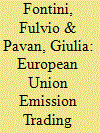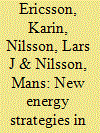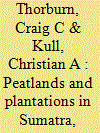|
|
|
Sort Order |
|
|
|
Items / Page
|
|
|
|
|
|
|
| Srl | Item |
| 1 |
ID:
112272


|
|
|
|
|
| Publication |
2012.
|
| Summary/Abstract |
The pulp and paper industry is a significant consumer of fossil energy in the Taiwanese manufacturing sector. The concentration of greenhouse gases (GHG) from manufacturing factory activities and vehicle emissions has increased remarkably. Notable energy savings can be achieved in the pulp and paper industry through energy flow analysis. The aim of this paper is to analyze the energy flow for three major energy consuming mills of the pulp and paper industry in Taiwan to make energy savings. In addition, potential technology options are examined for the capture of some of the energy that is currently lost in the processes and to identify the areas of energy saving potential that could have a large impact across more than one industry. The results of this study can serve as a benchmark for developing a quantified list in terms of energy savings potential and opportunities for improving the efficiency of the pulp and paper industry.
|
|
|
|
|
|
|
|
|
|
|
|
|
|
|
|
| 2 |
ID:
109424


|
|
|
|
|
| Publication |
2011.
|
| Summary/Abstract |
This study examines the historical relation between carbon dioxide emission and output growth in the Swedish pulp and paper industry from 1973 to 2006. We find that the industry achieved an 80 percent reduction in carbon dioxide emission, where most of the reduction took place before the implementation of active climate policy in 1991. Foremost energy substitution and also efficiency improvements contributed to the reduction. Growing prices of fossil fuel due to market price change and taxes and subsidies, explains most of the efficiency improvements and substitution. The study finds that energy transformation was coinciding with ongoing structural change in the industry during the 1970s and 1980s as well as a strong period of environmental adaption. We therefore suggest that the oil reduction was reinforced through the dynamics between the energy issue and an overall renewing process of the industry. This suggests a need to coordinate climate and environmental policy measures with the long-term industrial dynamics of structural change.
|
|
|
|
|
|
|
|
|
|
|
|
|
|
|
|
| 3 |
ID:
133312


|
|
|
|
|
| Publication |
2014.
|
| Summary/Abstract |
We evaluate the contribution of technological change in reducing CO2 emissions in the Italian pulp and paper industry during the first and second phases of application of the European Union Emission Trading System (EU-ETS). We decompose the variation in emission and emission intensity into three different types of effects: a composition effect, a technique effect and a scale effect. The composition effect measures the change in emissions and emissions intensity due to a shift in production towards products that cause less emissions. The technique effect measures the change per each type of product, thereby accounting for technology improvements in the production of each type of good produced. The scale effect singles out the reduction in total emission due to an overall reduction in output. We show that the first phase of the application of EU-ETS has led to a reduction in both emissions and emission intensity due to the composition effect. The technological change has had a limited negative impact on emissions in the first phase, while in the second phase there has been limited technology improvement in the industry. However, the figures of the scale effect show that the larger reduction in emission is due to the overall decrease in output.
|
|
|
|
|
|
|
|
|
|
|
|
|
|
|
|
| 4 |
ID:
121307


|
|
|
|
|
| Publication |
2013.
|
| Summary/Abstract |
This article examines to what extent and how the EU ETS has influenced the climate strategies of two Nordic pulp and paper companies: Swedish SCA and Norwegian Norske Skog. Rising electricity prices are perceived to be the greatest effect of the scheme. The EU ETS has served to reinforce commitments to improve energy efficiency and reduce CO2 emissions in both companies studied. Procedures like monitoring of CO2 emissions and accounting for CO2 prices have become more significant since the introduction of the EU ETS, but the scheme has not triggered a search for innovative, low-carbon solutions. Due to differences in market factors and production factors, SCA has been more active than Norske Skog in investing in and implementing CO2-lean actions. Future studies of climate-mitigation activities, strategies and innovations in the pulp and paper industry should involve more in-depth investigation of the interactions between such factors and the EU ETS.
|
|
|
|
|
|
|
|
|
|
|
|
|
|
|
|
| 5 |
ID:
103417


|
|
|
|
|
| Publication |
2011.
|
| Summary/Abstract |
The Swedish pulp and paper industry has gone through a strategic change in its approach to electricity production and consumption over the past decade. This paper documents this reorientation, which includes increased on-site electricity production, investments and investment plans for wind power, and new partnerships concerning investments in electricity production assets. We also assess the extent to which these changes can be attributed to key energy and climate policies. Our analysis shows that this strategic reorientation has been driven by changes in the underlying economic conditions for the pulp and paper industry, in particular increases in the price of electricity following the Swedish energy market reform in 1996, and the introduction of the EU ETS. The scheme for tradable renewable electricity certificates, on the other hand, has provided a new source of income. While these market-based signals and responses are the most dominant drivers of strategic change, cognitive changes in the pulp and paper industry have also played a role in the strategic reorientation. The cognitive changes concerning the functioning of the electricity market, i.e. the pricing of electricity and influence of the EU ETS, have been particularly important in this regard.
|
|
|
|
|
|
|
|
|
|
|
|
|
|
|
|
| 6 |
ID:
138264


|
|
|
|
|
| Summary/Abstract |
Peatlands play a crucial role in Indonesia's economic development, and in its stated goal of reducing greenhouse gas emissions. Improved peatland management – including a national moratorium on the granting of any new conversion licenses – forms a cornerstone of Indonesia's climate change mitigation commitment. At the same time, rapid expansion of the plantation sector is driving wide-scale drainage and conversion of peat swamp ecosystems. The province of Riau, in central Sumatra, finds itself at the crossroads of these conflicting agendas. This essay presents a case study of three islands on Riau's east coast affected by industrial timber plantation concessions. It examines the divergent experiences, perceptions and responses of communities on the islands. A mix of dramatic protests, localised everyday actions and constructive dialogue has succeeded in delaying or perhaps halting one of the concessions, while negotiations and contestation with the other two continue. With the support of regional and national non-governmental organisations and local government, communities are pursuing alternative development strategies, including the cultivation of sago, which requires no peat drainage. While a powerful political economy of state and corporate actors shapes the contours of socio-environmental change, local social movements can alter trajectories of change, promoting incremental improvements and alternative pathways.
|
|
|
|
|
|
|
|
|
|
|
|
|
|
|
|
|
|
|
|
|